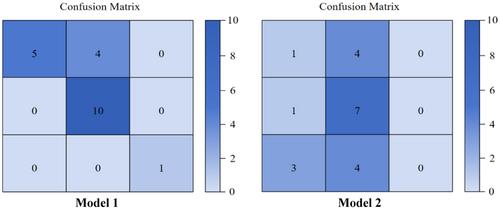The coronary artery disease-reporting and data system (CAD-RADS) 2.0 is used to standardize the reporting of coronary computed tomography angiography (CCTA) results. Artificial intelligence software can quantify the plaque composition, fat attenuation index, and fractional flow reserve.
To analyze plaque features of varying severity in patients with a combination of CAD-RADS stenosis and plaque burden categorization and establish a random forest classification model.
The data of 100 patients treated between April 2021 and February 2022 were retrospectively collected. The most severe plaque observed in each patient was the target lesion. Patients were categorized into three groups according to CAD-RADS: CAD-RADS 1−2 + P0−2, CAD-RADS 3−4B + P0−2, and CAD-RADS 3−4B + P3−4. Differences and correlations between variables were assessed between groups. AUC, accuracy, precision, recall, and F1 score were used to evaluate the diagnostic performance.
A total of 100 patients and 178 arteries were included. The differences of computed tomography fractional flow reserve (CT-FFR) (H = 23.921, p < 0.001), the volume of lipid component (H = 12.996, p = 0.002), the volume of fibro-lipid component (H = 8.692, p = 0.013), the proportion of lipid component volume (H = 22.038, p < 0.001), the proportion of fibro-lipid component volume (H = 11.731, p = 0.003), the proportion of calcification component volume (H = 11.049, p = 0.004), and plaque type (χ2 = 18.110, p = 0.001) was statistically significant.
CT-FFR, volume and proportion of lipid and fibro-lipid components of plaques, the proportion of calcified components, and plaque type were valuable for CAD-RADS stenosis + plaque burden classification, especially CT-FFR, volume, and proportion of lipid and fibro-lipid components. The model built using the random forest was better than the clinical model (AUC: 0.874 vs. 0.647).



